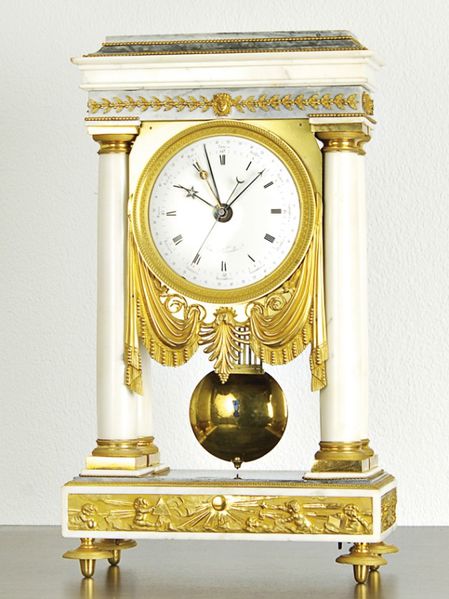Datei:Thomé à Versailles, circa 1795 (1).jpg

Originaldatei (641 × 855 Pixel, Dateigröße: 166 KB, MIME-Typ: image/jpeg)
Thomé à Versailles, 550 x 320 x 160 mm, circa 1795

|
Alle Bildrechte liegen bei dem Auktionshaus Auktionen Dr. H. Crott. Diese Abbildung ist urheberrechtlich geschützt und steht nicht unter einer freien Lizenz. Für anderweitige Nutzungen außerhalb von Watch-Wiki ist die schriftliche Zustimmung des Urheberrechtsinhabers nötig. |
Directoire Präzisions-Tischregulator mit Datumsanzeige, Äquation, Zentralsekunde und Viertelstunden-/Stundenselbstschlag mit einem Hammer auf drei Glocken von Robin und Berthoud Geh.: weißer und grauer Marmor, feuervergoldete Bronze. Ziffbl.: Email, äußere Monatsnamen mit Datum, innen radiale röm. Stunden. Fünf separate Zeiger: vergoldeter Zeiger für Äquationsanzeige, gebläute Zeiger für Stunden- und Minute, Kalender und Zentralsekunde, verdeckte Aufzüge. Werk: quadratisches Messing-Vollplatinenwerk, 1 Hammer / 3 Glocken, nierenförmiger Äquationsmechanismus unter dem Zifferblatt, Scherenhemmung, Kompensations-Rostpendel mit Schneidenaufhängung.
Der wie eine Portaluhr gestaltete Regulator zeichnet sich durch sein klar stukturiertes weißes Emailzifferblatt aus, das neben dem Datum und dem Monat auch die Äquation, also die Differenz zwischen zwischen der wahren Sonnenzeit und der mittleren Sonnenzeit, mittels eines goldfarbenen Sonnenzeigers anzeigt. Eingebettet ist das Zifferblatt zwischen einem Doppelsäulenpaar aus weißem Marmor mit vergoldeten Basen und Kapitellen und ist verziert mit einer golfarbenen, aufwändig gestalteten Draperie. Das Oberteil aus weißem und grauem Marmor hat ein umlaufendes, vergoldetes Zierband aus Lorbeer und zentralem Medusenhaupt, der rechteckige Sockel ein goldfarbenes Zierfries mit Flachrelief. Dargestellt sind acht lebhaft agierende Putti, die unter einer Sonne im Zentrum der Sockelplatte mit verschiedenen, geometrischen Formen spielen. Sie verkörpern die acht Planeten unseres Sonnensystems, dessen Mittelpunkt die Sonne ist und von allem umkreist wird. Zu jeder halben und vollen Stunde wird die Uhrzeit akustisch durch Schläge auf drei Glocken angezeigt, wobei ein einzelner Hammer alle drei Glocken bedient, indem er seine Länge dementsprechend verändert.
Thomé à Versailles, 550 x 320 x 160 mm, circa 1795
A Directoire precision table regulator with indications of date and equation of time, centre seconds and quarter hour/hour self strike with one hammer striking on three bells by Robin and Berthoud Case: white and grey marble, ormolu. Dial: enamel, outer names of the months with date, inner radial Roman hours. Five separate hands: gilt hands for the equation, blued hands for the hours and minutes, the calendar and centre seconds, concealed winding apertures. Movm.: square brass full plate movement, 1 hammer / 3 bells, kidney-shaped device for equation of time under the dial, pin wheel escapement, compensation gridiron pendulum with knife edge suspension.
The distinguishing feature of this regulator in the form of a portal is the clear-cut design of its white enamel dial, which shows not only date and month but also the equation of time, i.e., the discrepancy between solar time and mean solar time, by means of a gold-coloured hand with a sun symbol. The dial sits between a pair of white marble double columns with gilded bases and capitals and is decorated with a heavy, gold-coloured drapery. The top part of the clock is made of white and grey marble with a gilt laurel band around it and a central Medusa head. The rectangular base is decorated with a gold-coloured frieze with bas-relief; it shows a sun in the centre and eight lively putti playing with different geometric objects. The putti symbolize the eight planets in our solar system orbiting the sun. Time is announced at every half and every full hour by strikes on three bells, with a single hammer striking all three clocks by changing its length accordingly.
The records of Brian Loomes show that Thomé was mentioned as a clockmaker in Versailles in the second half of the 18th century. Source: Brian Loomes, "Watchmakers and Clockmakers of the World, London 2006, p. 766.
Dateiversionen
Klicke auf einen Zeitpunkt, um diese Version zu laden.
| Version vom | Vorschaubild | Maße | Benutzer | Kommentar | |
|---|---|---|---|---|---|
| aktuell | 16:36, 9. Mai 2018 |  | 641 × 855 (166 KB) | Andriessen (Diskussion | Beiträge) | Thomé à Versailles, 550 x 320 x 160 mm, circa 1795 {{Bildrechte U|dem Auktionshaus Auktionen Dr. H. Crott}} Directoire Präzisions-Tischregulator mit Datumsanzeige, Äquation, Zentralsekunde und Viertelstunden-/Stundenselbstschlag mit einem Hamm… |
Du kannst diese Datei nicht überschreiben.
Dateiverwendung
Die folgende Seite verwendet diese Datei:
- Bildgalerie Uhrenmodelle Thomé à Versailles
- Picture gallery watch models Thomé à Versailles
- Galería de imagenes de modelos de relojes Thomé à Versailles
- Afbeeldingen galerij uurwerkmodellen Thomé à Versailles
- Фотогалерея Модели часов Thomé à Versailles
- Galleria fotografica di modelli orologi Thomé à Versailles